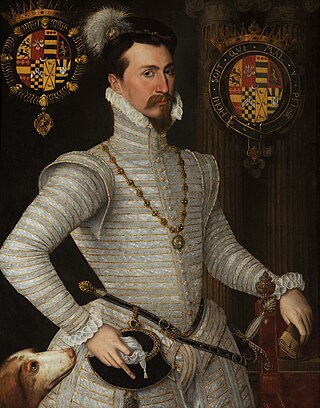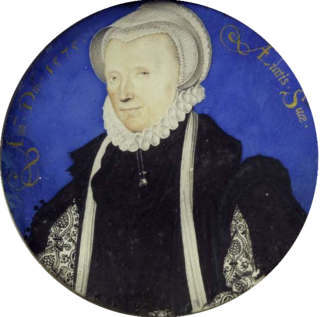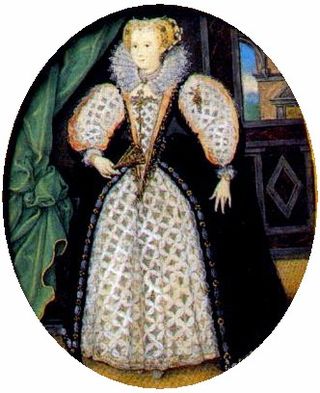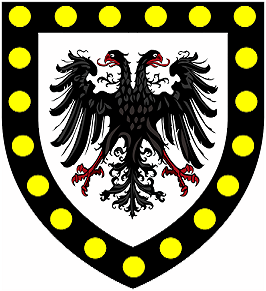
Edward de Vere, 17th Earl of Oxford, was an English peer and courtier of the Elizabethan era. Oxford was heir to the second oldest earldom in the kingdom, a court favourite for a time, a sought-after patron of the arts, and noted by his contemporaries as a lyric poet and court playwright, but his volatile temperament precluded him from attaining any courtly or governmental responsibility and contributed to the dissipation of his estate.

Robert Dudley, 1st Earl of Leicester, was an English statesman and the favourite of Elizabeth I from her accession until his death. He was a suitor for the queen's hand for many years.

The masque was a form of festive courtly entertainment that flourished in 16th- and early 17th-century Europe, though it was developed earlier in Italy, in forms including the intermedio. A masque involved music, dancing, singing and acting, within an elaborate stage design, in which the architectural framing and costumes might be designed by a renowned architect, to present a deferential allegory flattering to the patron. Professional actors and musicians were hired for the speaking and singing parts. Masquers who did not speak or sing were often courtiers: the English queen Anne of Denmark frequently danced with her ladies in masques between 1603 and 1611, and Henry VIII and Charles I of England performed in the masques at their courts. In the tradition of masque, Louis XIV of France danced in ballets at Versailles with music by Jean-Baptiste Lully.

The Faerie Queene is an English epic poem by Edmund Spenser. Books I–III were first published in 1590, then republished in 1596 together with books IV–VI. The Faerie Queene is notable for its form: at over 36,000 lines and over 4,000 stanzas, it is one of the longest poems in the English language; it is also the work in which Spenser invented the verse form known as the Spenserian stanza. On a literal level, the poem follows several knights as a means to examine different virtues. The poem is also an allegorical work. As such, it can be read on several levels, including as praise of Queen Elizabeth I. In Spenser's "Letter of the Authors", he states that the entire epic poem is "cloudily enwrapped in Allegorical devices", and that the aim of publishing The Faerie Queene was to "fashion a gentleman or noble person in virtuous and gentle discipline".

Margaret Douglas, Countess of Lennox, was the daughter of the Scottish queen dowager Margaret Tudor and her second husband Archibald Douglas, 6th Earl of Angus, and thus the granddaughter of King Henry VII of England and the half-sister of King James V. She was the grandmother of King James VI and I.

George Gascoigne was an English poet, soldier and unsuccessful courtier. He is considered the most important poet of the early Elizabethan era, following Sir Thomas Wyatt and Henry Howard, Earl of Surrey and leading to the emergence of Philip Sidney. He was the first poet to deify Queen Elizabeth I, in effect establishing her cult as a virgin goddess married to her kingdom and subjects. His most noted works include A Discourse of the Adventures of Master FJ (1573), an account of courtly intrigue and one of the earliest English prose fictions; The Supposes,, an early translation of Ariosto and the first comedy written in English prose, which was used by Shakespeare as a source for The Taming of the Shrew; the frequently anthologised short poem "Gascoignes wodmanship" (1573) and "Certayne Notes of Instruction concerning the making of verse or ryme in English" (1575), the first essay on English versification.

Thomas Radclyffe, 3rd Earl of Sussex KG, was Lord Deputy of Ireland during the Tudor period of English history, and a leading courtier during the reign of Elizabeth I.

Sir Christopher Hatton KG was an English politician, Lord Chancellor of England and a favourite of Elizabeth I of England. He was one of the judges who found Mary, Queen of Scots guilty of treason.

Penelope Rich, Lady Rich, later styled Penelope Blount was an English court office holder. She served as lady-in-waiting to the English queen Anne of Denmark. She was the sister of Robert Devereux, 2nd Earl of Essex, and is traditionally thought to be the inspiration for "Stella" of Sir Philip Sidney's Astrophel and Stella sonnet sequence. She was married to Robert Rich, 3rd Baron Rich and had a public liaison with Charles Blount, Baron Mountjoy, whom she married in an unlicensed ceremony following her divorce from Rich. She died in 1607.
William Painter was an English author and translator. As a clerk of the Ordnance in the Tower of London, he was accused of fraud aimed at amassing a personal fortune at public expense. He is best known for his anthology of translations, The Palace of Pleasure.
William Webbe was an English critic and translator. He attended Trinity College, Cambridge, and was a tutor for distinguished families, including the two sons of Edward Sulyard of Flemyngs, Essex, and later the children of Henry Grey of Pirgo, also in Essex.
Thierry and Theodoret is a Jacobean era stage play, a tragedy in the canon of John Fletcher and his collaborators that was first published in 1621. It is one of the problematic plays of Fletcher's oeuvre; as with Love's Cure, there are significant uncertainties about the date and authorship of Thierry and Theodoret.

The Fatal Contract: A French Tragedy is a Caroline era stage play, written by William Heminges. The play has been regarded as one of the most extreme of the revenge tragedies or "tragedies of blood," like The Spanish Tragedy and Titus Andronicus, that constitute a distinctive subgenre of English Renaissance theatre. In this "most graphic Caroline revenge tragedy...Heminges tops his predecessors' grotesque art by creating a female character, Chrotilda, who disguises herself as a black Moorish eunuch" and "instigates most of the play's murder and mayhem."

Sir Henry Killigrew was a diplomat and an ambassador for the Kingdom of England in the sixteenth century. He was several times employed by Elizabeth I in Scottish affairs and served as one of the English appointees to the Council of State of the Netherlands in the United Provinces in 1586 and 1587–1589. He served as a Member of Parliament for Newport & Launceston in 1553, for Saltash in 1563, and for Truro in 1571–2.

Elizabeth Knollys, Lady Leighton, was an English courtier who served Queen Elizabeth I of England, first as a Maid of Honour and secondly, after 1566, as a Gentlewoman of the Privy Chamber. Knollys was the grand-niece of Queen consort Anne Boleyn, which made her a cousin once removed of the Queen. Elizabeth married Sir Thomas Leighton of Feckenham in Worcestershire in 1578. He served as Governor of Jersey and Guernsey.
Chidiock Paulet was an English politician and Captain of Portsmouth. He was born the third son of William Paulet, 1st Marquess of Winchester and educated at the Inner Temple. His unusual name originates from the village of Chideock, Dorset, which was held by Arundells to whom his family were related by marriage.
Robert Wilmot was a Church of England clergyman, known as a playwright.

The revels were a traditional period of merrymaking and entertainment held at the Inns of Court, the professional associations, training centres and residences of barristers in London, England. The revels were held annually from the early 15th to the early 18th centuries and were an extension of a general nationwide period of entertainment running from All Saints' Eve to Candlemas, though in some years they lasted as late as Lent. The inns elected a "prince" to lead the festivities and put on a sequence of elaborate entertainments and wild parties. The events included singing, dancing, feasting, the holding of mock trials and the performance of plays and masques. The revels played an important part in encouraging early English theatre and provided William Shakespeare with one of his most distinguished audiences in his early career. Several plays were written specifically for the revels and legal scenes in many plays from this era may have been written with this audience in mind. The revels declined in the 17th century and they last appear to have been held in 1733. The inns revived the revels in the mid 20th-century and they now comprise a seasonal offering of entertainment in the form of sketches, songs and jokes.
Evelyn Mary Simpson was an English literary critic and scholar, and the first woman to earn a D.Phil. from Oxford University. Though she was required to relinquish her appointment at St Hugh's College, Oxford upon marrying in 1921, Simpson continued her work as an independent scholar. She is best known for her scholarship on John Donne, including a magisterial edition of his sermons and editions of other prose works, but she wrote on other topics in English Renaissance literature as well.
Marie Axton (1937–2014), birth name Marie Horine, was an American scholar of Elizabethan drama, who made her academic career in the United Kingdom. She married Richard Axton of Christ's College, Cambridge in 1962. In 1979 she became the first woman appointed a junior proctor by the University of Cambridge.














